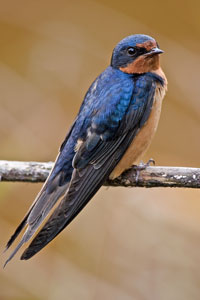

|
Barn Swallow (Hirundo rustica) Description: The barn swallow is about six inches long, and has slate blue wings and head. It has a dark orange throat and forehead and a paler orange chest and underside. It has a deeply forked tail. Males and females look alike. (Photo courtesy of naturespicsonline.com) Calls: A twittery series of squeaky notes, often with dry rattle in the middle.Listen to calls of this species » 
Range / Habitat: In North America, barn swallows breed from Alaska east to Newfoundland, Canada and south to California and east to northern Florida. The barn swallow winters in the tropics south to Argentina. The barn swallow also breeds in northern Europe, northeastern Asia, the Middle East and Northern Africa. European and Asian barn swallows winter in southern Asia and Indonesia and Micronesia. The barn swallow can be found in farmlands, suburbs, marshes and lakeshores. Click the range map to learn more about the distribution of Barn Swallows. Diet: The barn swallow only eats insects. Nesting: Barn swallows often mate in the air. Both parents build the nest. Nests are made of mud and lined with grass and feathers. The cup-shaped nest is built under a rock ledge or in the rafters or eaves of buildings. The female lays four to six eggs. Both parents help incubate the eggs and care for the young. The eggs take around two weeks to hatch and the chicks will fledge when they are about three weeks old. The female may have two broods a year Behavior: Barn swallows are Neotropical migrants. They travel by day, eating as they fly. They can even feed their young while they are in flight! They can travel as many as 600 miles a day. Barn swallows migrate in large groups. Did you know?
More Information
Barn Swallow - All About Birds Animal silhouettes available to purchase » Photos: Natures Pics
|